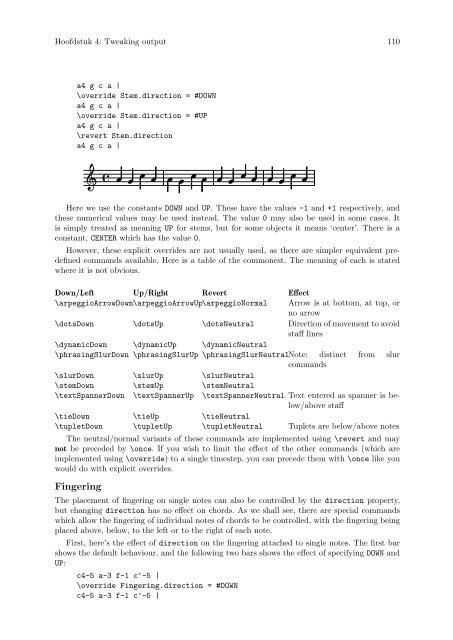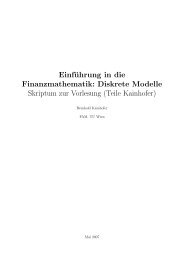LilyPond Beginnershandleiding
LilyPond Beginnershandleiding
LilyPond Beginnershandleiding
You also want an ePaper? Increase the reach of your titles
YUMPU automatically turns print PDFs into web optimized ePapers that Google loves.
Hoofdstuk 4: Tweaking output 110<br />
a4 g c a |<br />
\override Stem.direction = #DOWN<br />
a4 g c a |<br />
\override Stem.direction = #UP<br />
a4 g c a |<br />
\revert Stem.direction<br />
a4 g c a |<br />
<br />
<br />
<br />
<br />
<br />
<br />
<br />
Here we use the constants DOWN and UP. These have the values -1 and +1 respectively, and<br />
these numerical values may be used instead. The value 0 may also be used in some cases. It<br />
is simply treated as meaning UP for stems, but for some objects it means ‘center’. There is a<br />
constant, CENTER which has the value 0.<br />
However, these explicit overrides are not usually used, as there are simpler equivalent predefined<br />
commands available. Here is a table of the commonest. The meaning of each is stated<br />
where it is not obvious.<br />
Down/Left Up/Right Revert Effect<br />
\arpeggioArrowDown\arpeggioArrowUp\arpeggioNormal Arrow is at bottom, at top, or<br />
no arrow<br />
\dotsDown \dotsUp \dotsNeutral Direction of movement to avoid<br />
staff lines<br />
\dynamicDown \dynamicUp \dynamicNeutral<br />
\phrasingSlurDown \phrasingSlurUp \phrasingSlurNeutralNote: distinct from slur<br />
commands<br />
\slurDown \slurUp \slurNeutral<br />
\stemDown \stemUp \stemNeutral<br />
\textSpannerDown \textSpannerUp \textSpannerNeutral Text entered as spanner is below/above<br />
staff<br />
\tieDown \tieUp \tieNeutral<br />
\tupletDown \tupletUp \tupletNeutral Tuplets are below/above notes<br />
The neutral/normal variants of these commands are implemented using \revert and may<br />
not be preceded by \once. If you wish to limit the effect of the other commands (which are<br />
implemented using \override) to a single timestep, you can precede them with \once like you<br />
would do with explicit overrides.<br />
Fingering<br />
The placement of fingering on single notes can also be controlled by the direction property,<br />
but changing direction has no effect on chords. As we shall see, there are special commands<br />
which allow the fingering of individual notes of chords to be controlled, with the fingering being<br />
placed above, below, to the left or to the right of each note.<br />
First, here’s the effect of direction on the fingering attached to single notes. The first bar<br />
shows the default behaviour, and the following two bars shows the effect of specifying DOWN and<br />
UP:<br />
c4-5 a-3 f-1 c'-5 |<br />
\override Fingering.direction = #DOWN<br />
c4-5 a-3 f-1 c'-5 |



